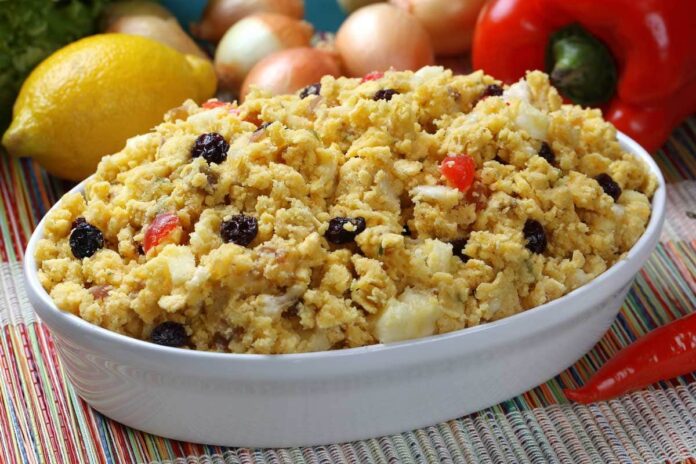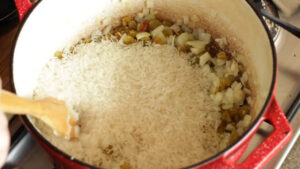
Brazilian rice with raisins brings tropical flair to any holiday meal, blending champagne, raisins, and cashews in one festive dish.
Perfect with turkey or roasted meats, it reflects Brazil’s summer-style Christmas, where barbecues and cold drinks replace snow and fireplaces—read more about that here.
Dried fruits and nuts carry a deeper meaning, symbolizing prosperity across holiday tables in salads, desserts, and flavorful sides.
For a flavorful bite of tradition, try this recipe and enjoy a true Christmas in Brazil.

Recipe for Brazilian Rice with Raisins
Equipment
- Medium saucepan with lid
- Wooden spoon or spatula
- Measuring Cups and Spoons
- Knife and cutting board
- Small bowl for soaking raisins
Ingredients
- 1 Tbsp Olive oil
- ½ Onion sliced
- 2 Cloves Garlic, minced
- 1 Cup Uncooked rice rinsed
- ¾ Cup Champagne
- ½ Cup Raisins
- 1¼ Cup Water
- ½ Cup Cashews roughly chopped
- Salt to taste ~½ tsp to 1 tsp per cup of rice
Instructions
- Prepare the Raisins:Soak the raisins in champagne for 30 minutes to 1 hour. Set aside.
- Cook the Onions:Heat olive oil in a medium saucepan over medium heat. Add sliced onions and sauté until soft and translucent.
- Add Garlic:Stir in minced garlic and cook until fragrant, about 1 minute.
- Toast the Rice:Add the rinsed rice to the saucepan, sprinkle with salt, and stir well. Cook for 1 minute to lightly toast the rice.
- Cook with Champagne:Drain the soaked champagne from the raisins into the saucepan. Cook until the champagne has reduced and nearly evaporated.
- Add Water:Pour in the water and bring the mixture to a gentle boil. Reduce heat to a simmer, cover, and cook until all water is absorbed and rice is tender (about 10-12 minutes). Avoid opening the lid during cooking to retain steam.
- Steam the Raisins:Turn off the heat, add the soaked raisins to the cooked rice, and immediately cover the saucepan. Let the rice sit, covered, for 10 minutes to steam.
- Add Cashews and Serve:Before serving, stir in the chopped cashews for added crunch. Optionally, mold the rice into a decorative wreath shape for presentation.
Video
Notes
- Customize the Dried Fruits: Swap raisins for dried cranberries or chopped apricots for a twist.
- Make it Vegan: Use sparkling white grape juice instead of champagne.
- Rice Choices: Use long-grain or basmati rice for the best texture.
What is the most popular food in Brazil?
Brazil is famous for its diverse and flavorful cuisine, with feijoada (a black bean and pork stew) often considered the national dish.
Other popular foods include pão de queijo (cheese bread), brigadeiros (chocolate truffles), and churrasco (Brazilian barbecue).
Each region of Brazil has its own specialties, showcasing the country’s rich culinary heritage.
When is the best time to visit Brazil?
The best time to visit Brazil depends on your preferences. For those who enjoy warm weather and beach activities, the summer months (December to March) are ideal.
If you’re interested in experiencing Carnival, plan your trip in February or early March. For cooler weather and fewer crowds, consider visiting during the winter months (June to August).
What are some traditional Christmas dishes in Brazil?
In addition to Christmas rice, Brazilians often enjoy dishes like roast turkey, tender pork loin, and farofa (toasted cassava flour with herbs and bacon).
Desserts like rabanadas (Brazilian-style French toast) and panettone are also common on the Christmas table.
Last Words
Christmas in Brazil is about good food, family, and enjoying the season together.
The Brazilian rice with raisins is a simple dish that brings a taste of those traditions to your table.
Try it out, and enjoy a little piece of Brazil this holiday.
























